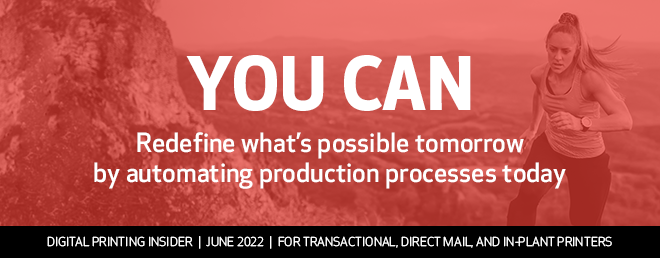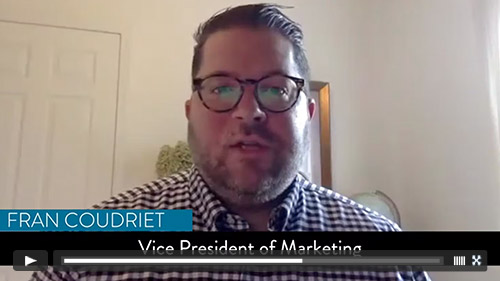Revolutionizing the Production Process Through Automation
What if anything were possible? In today’s technologically defined print landscape, where new technologies and workflow processes continue to dominate the headlines, the answer to that question is not really as far-fetched as it seems. Allen Filson, Sr., Director of Professional Services at Canon Solutions America (CSA), Production Print Solutions, recalls a conversation with a book publisher that was caught up in the closing of famed book and journal printer Edwards Brothers Malloy. After nearly 125 years in business, the Ann Arbor, Michigan printer shut down its offset and digital presses in 2018, ending a storied run for the independent, family-run business.
The book publisher found itself in a precarious situation, unable to produce its orders. For Filson and the Canon Solutions America team, the situation, while dire at first blush, just took some hard, succinct reasoning to decipher with the publisher. For a company where innovation drives the engine to problem-solving on any given day, laying out the problem printers are faced with and building a bridge to a solution is all in a day’s work, so to speak. “The goal is to help transform businesses from what their customers used to be, to what they have always dreamed of becoming. It’s in our DNA I guess.”
While NDAs preclude Filson from mentioning specific customers and their intellectual property, he can discuss how automation helps Canon Solutions America do what it does. That includes working closely with a customer’s staff before discussing any products, software or process changes. The CSA team typically spends eight to 10 hours uncovering everything a print service provider does and how they do it. Once the details are captured, they seek areas of improvement, working on developing that “if anything were possible” concept.
“With shortages in labor and demands to collaborate with clients in remote manner, technology and automation need to serve a stronger role.” — Matt Reville, CEO, Consolidated Solutions
“This involves discussing processes the customer feels could be improved or find difficult,” Filson says. “Once we isolate these, we start talking about how these things could be handled in an automated fashion. We may even build a Visio diagram of how the new automated systems could work. We gain buy-in from the staff and finally after the concepts have been reviewed and discussed and agreed to, we offer solutions to make the new systems a reality.”
In the case of the aforementioned book publisher, the Canon Solutions America team simply followed the process and eventually helped turned the publisher into a fully functioning book-of-one manufacturer. This, Filson says, from a company that had never printed a single book itself. Today, along with producing its own orders, the book publisher is working on orders for some of the largest online retailers in the world. “It’s not just inkjet presses; it’s a holistic look at production processes and taking the time to indeed build a better mousetrap—one that can not only prepare your business for the future, but leave your competitors wondering how you are able to do what you do.”
Seventeen years ago, Filson was lucky enough to help build one of the world’s first fully lights out prepress environments for a global book manufacturer. Systems like those helped change the industry. Book-of-one now is possible directly because Canon Solutions America figured out how to batch like work together and run orders in the most effective and efficient manner possible for the printing and finishing backend processes.
“When it comes to automation, you really need to work from the end of the production process backward,” Filson says. “What is best for finishing, then insertion, then the press room (etc.)? When you do this, your automated workflow will become effective in helping to streamline your business, reduce internal costs, and reduce turn times of orders. All of this helps you stay highly competitive in what has always been a competitive industry.”
The Amazon Effect
The need for printers to stay in step with automation is not a secret formula. Lower internal costs, faster customer turn times, shorter print runs, etc., is where the print industry is today. If a printer is not looking into automating its internal processes, it will struggle to stay competitive. Why should a customer wait for a 10-day turn time when the printer down the street can do it in 48 hours?
Think of the Amazon effect. If the customer needs something tomorrow, that something can be delivered tomorrow. And they do not have to leave the house. The print industry is transforming in much the same way.
Forty-eight hour turn times are real and happening because of things like automated workflow systems, hands-free prepress, automated proofing, JDF/XML data exchanges and real time job status reporting. Automation gives printers these abilities, and more.
“I always think of a company in Montana that ran video ads looking for employees to move to one of the most beautiful parts of our country,” Filson says. “It was an early adopter of automation. What used to be apprenticeship programs to become a press operator or film stripper has now given way to XML/JDF/API communications between systems and companies. You no longer need ‘Big Iron’ to compete in today’s world. You have companies shedding conventional printing presses and going fully digital. The gap between offset and inkjet quality is gone.”
With the print industry continuing to be relevant and a critical medium to support communication in many ways, Matt Reville believes print manufacturers are having to become more strategic with their sales approaches. Combining print with technology to manage messaging and production is key to supporting the demands of the market.
Reville, CEO of Consolidated Solutions, a 24/7 full service solutions provider in Cleveland, says that today’s printer must continue to embrace the automation revolution. “Automation allows for less touch points, instant information regarding projects and seamless transfer of information between manufacturing and management systems. With the right automation a company can benefit by lowering operational costs, improving the quality of information and increasing revenue while shortening the time to invoicing.”
And there is another, even more enticing proposition regarding automation: It will continue to attract the next generation of print workers. “The next generation of the workforce will be more intrigued by the print business if there are elements to emerging technology such as augmented reality, CRM integration, social media integration and manufacturing automation,” Reville says. “We are offering advancement in our company to learn more automated manufacturing methods and pieces of equipment. We also offer opportunities through scholarships to learn more about new technology. We also offer bonuses to employees that find new ways to produce items in a more efficient manner.”
At Consolidated Solutions, the proof continues to be in its actions. For example, the company recently installed its third continuous print system. The devices have allowed Consolidated to produce high volumes of printed documents in short periods of time. The most recent installation will lower the need to print offset shells and will take several steps out of the manufacturing process. “With shortages in labor and demands to collaborate with clients in remote manner, technology and automation need to serve a stronger role,” Reville says. “Fully automated solutions are needed to execute projects from the initial order through delivery to meet these demands.”
“The goal is to help transform businesses from what their customers used to be, to what they have always dreamed of becoming. It’s in our DNA I guess.” — Allen Filson, Sr. Director of Professional Services, Canon Solutions America, Production Print Solutions
In a time when automation continues to hit at the heart of the industry’s sustainability, building and acquiring better, more effective mouse traps can be an exciting and rewarding premise. As printers continue to find ways to streamline processes and increase efficiencies, manufacturers will continue to abide. “The most effective people who do what I do are people who can’t see the impossible,” Filson says. “I gave out stickers to my whole team four or five years ago that said, ‘Impossibility is only an opinion, not a destination.’”
Today, that mantra is what’s driving the print industry and its ambitions forward.
Did you know?
A combination of customer demand and digital press choices will drive digital press investment and print volume in 2022. Read this NAPCO report about the market forces driving the demand and the strategies to take advantage of them.


